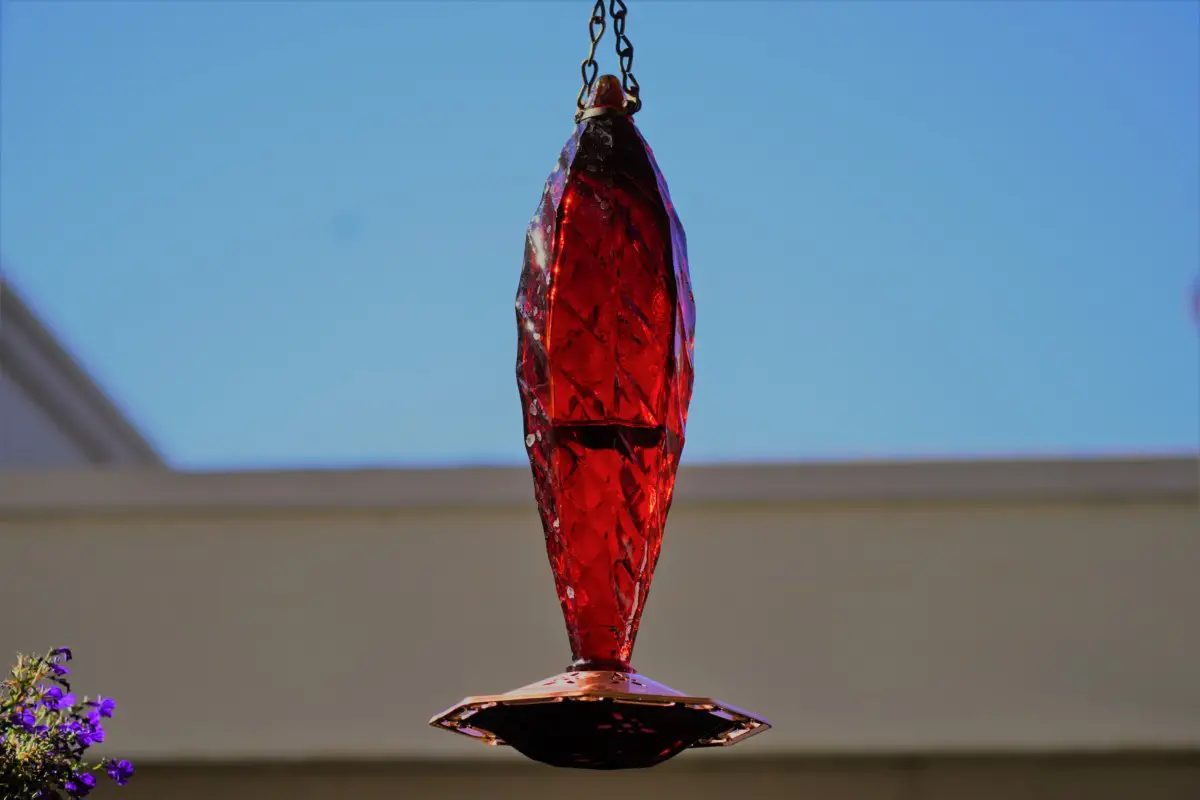This post contains affiliate links.
Have you ever had a season where you witnessed fewer hummingbirds visiting your feeders than the previous year and found yourself asking, “What am I doing wrong?” Well, you are not alone. It sounds easy to say, “hang a hummingbird feeder and they will come”. There are several easily identifiable factors and some less obvious ones when answering this universal question.
Why won’t hummingbirds come to my feeder?
Hummingbirds are not coming to my feeder for one or more of the following six reasons: Unattractive hummingbird oasis; unable to locate the feeder; fermenting hummingbird nectar; bees on the feeder; seasonal migrants; and the presence of potential predators.
I will discuss the reasons why hummingbirds may not be visiting your feeders and simple solutions on how to entice these inquisitive, hungry hummingbirds.
Unattractive Hummingbird Oasis
Do you have a dry, waterless, barren backyard? Wonder why it’s difficult to capture any hummingbird activity? It might be time to give your backyard a makeover!
Just like men and women dress up to look their best with the goal of catching the eye of a potential mate, adult male hummingbirds rely on attractive and abundant flowering backdrops to stage their theater when gearing up to catch their potential mate.
There are 9 easy steps to attract hummingbirds to a backyard oasis:
- Choose the color red
- Make homemade nectar
- Keep hummingbird feeders clean
- Prevent bees and wasps invasion
- Eliminate pesticides and predators
- Remove territorial bullies
- Provide available protein
- Include a water feature
- Plant flowers with prolific blossoms
Choose the Color Red
Hummingbirds always have food on their mind and are attracted to the natural abundance of colorful food sources. They are allured by the color red and are drawn toward tubular-shaped flowers. They also gravitate towards hummingbird feeders with red bases and red flowers.
Make Homemade Nectar
Prepare homemade nectar by using 1 cup of granulated white cane sugar dissolved in 4 cups of filtered water. Do NOT use honey, organic or artificial sugars. Using red dye in homemade nectar is unnecessary and potentially harmful to hummingbirds.
Learn more tips and see my article: Forget Commercial Hummingbird Food, Try Making Homemade Nectar
Keep Hummingbird Feeders Clean
Cleaned and regularly changed hummingbird feeders will prevent homemade nectar from fermenting. Bacteria spread easily in warm weather.
Bacteria-ridden hummingbird feeders infect and contaminate hummingbirds with just one overcrowded feeder. Be mindful to not contribute to any unnecessary deaths.
Prevent Bees and Wasps
Over-sweetened homemade nectar, for example, 1 part sugar to 2 parts water attracts unwanted visitors such as bees and wasps. Experiment with the recommended recipe guidelines for the homemade hummingbird nectar of 1 part sugar to 4 parts water and try reducing the recipe to 1 part sugar to 5 parts water ratio to minimize bee visitors.
Bees are after sugar and water for hydration during the hot summer heat. Bee watering stations are a wonderful addition to your hummingbird sanctuary.
Eliminate Pesticides and Predators
Remove any harmful pesticides or chemical agents that are used to cure or protect a plant from insects or diseases.
Home pets along with outdoor wildlife such as hawks, crows, spiders, and praying mantis can also harm hummingbirds.
Remove Territorial Bullies
When male hummingbirds start to show too much aggression, rotate and increase the distance between the feeders. The farther apart the feeders, the more effort and energy a bullying male hummingbird must expend to secure his territory.
Provide Available Protein
Adding a variety of proteins to your environment by attracting small bugs, aphids, gnats, leaf-hoppers, flies, mosquitoes and spiders contributes to a well-balanced diet for the hummingbirds.
A compost area with added layers of kitchen scraps, such as apple and carrot peelings, along with backyard grass and leaf clippings produces rich nutrient organic soil for your yard. This compost also furnishes protein-rich bugs for hummingbirds.
If you don’t have space for a compost pile, hanging bananas outside under your eave and allowing them to ripen as an easy way to attract gnats for your hummingbirds. If you are patient and lucky, you will see the hummingbirds perform acrobatic maneuvers as they pluck the bugs from the air.
Include a Water Feature
Water is a key survival component of life and is also a welcoming element to hydrate nectar-producing flowering plants. Supplying the plants with necessary showers allows them to pass along an abundance of sweet nectar to the flowers providing accessible food, fuel, and ultimately energy for the hummingbirds.
Hummingbirds are intrigued by the sound of running water, therefore, placing feeders next to a water feature will guarantee they locate your feeder.
Plant Flowers with Prolific Blossoms
Plant prolific nectar-producing flowering plants such as shaded perennials, drought tolerant full sun shrubs, vines, and even trees. Select plants that bloom throughout the 4 seasons to guarantee a never-ending and constant supply of food for the hummingbirds.
Four examples below showcase nectar-producing flowering plants from the longest to the shortest season.
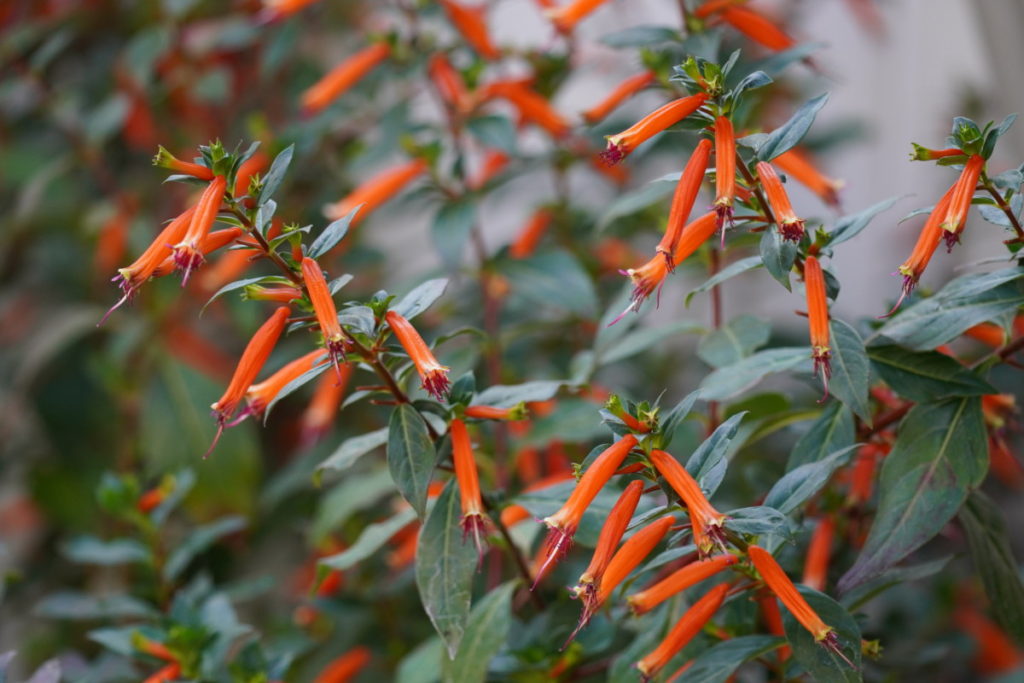
Flowers year round
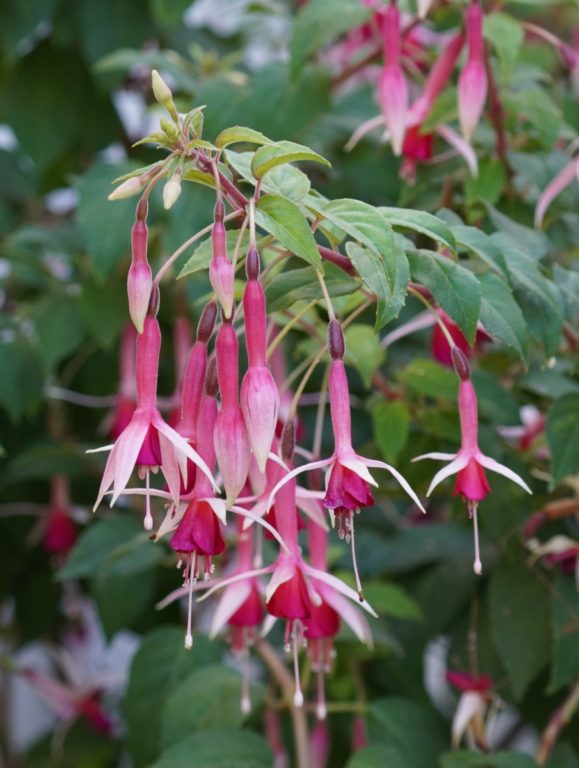
Flowers all of summer and some of fall
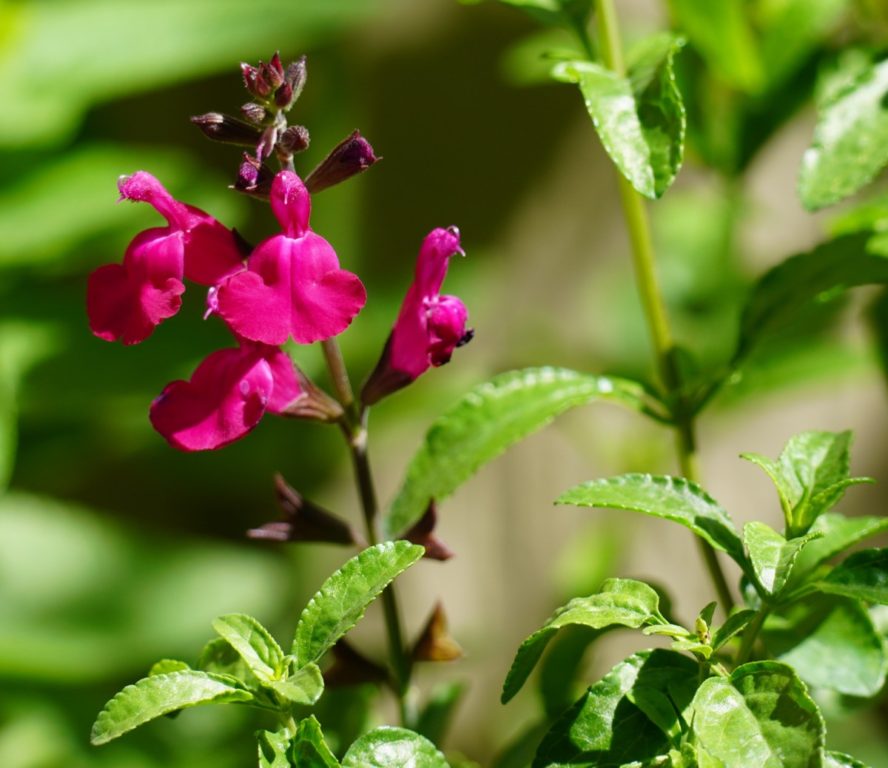
Flowers spring and fall
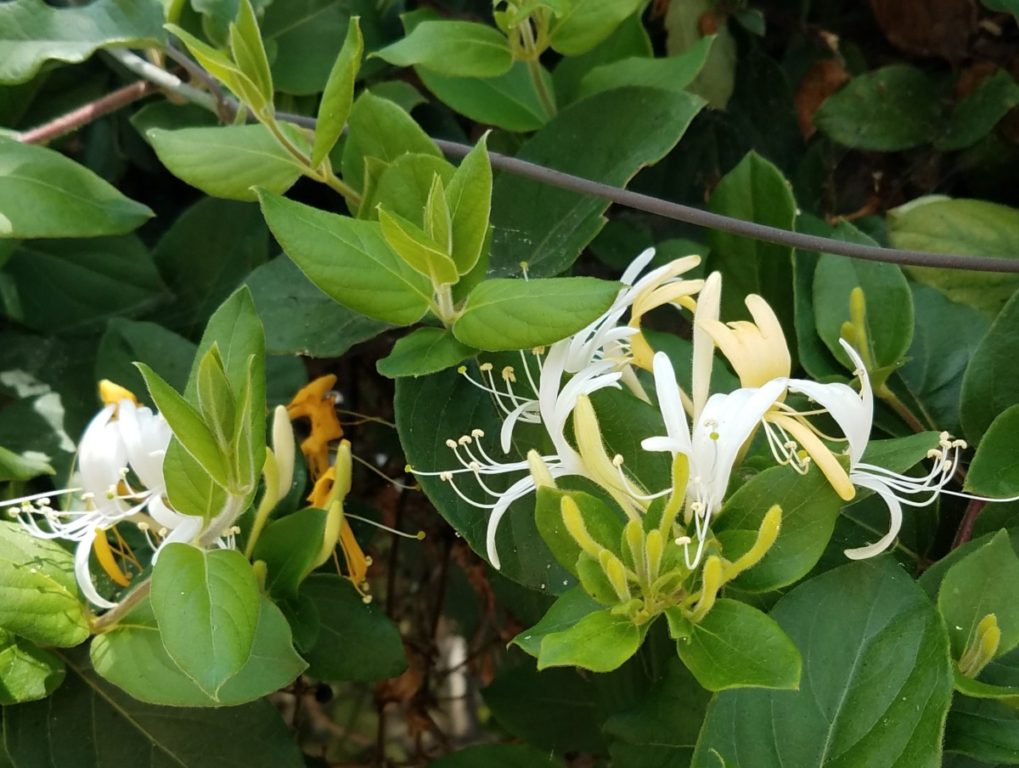
Flowers late spring and early fall
The Japanese Honeysuckle is an invasive plant that is not recommended by botanists in the United States, but it is the honeysuckle variety I have in my yard and the hummingbirds love it.
A better option would be the trumpet honeysuckle (link to a picture and article about the Trumpet Honeysuckle).
Understanding what hummingbirds are seeking and enticing them into your space is the first major step in this process. Combining all of these useful tips will not only expand your hummingbird participation in your yard but will create an unbelievable visual extravaganza desired by everyone.
For more in depth information, see my article on Increase Backyard Hummingbird Activity in 7 Days or Less
Unable to Locate the Feeder
Feeder placement is crucial for hummingbirds to successfully find their nectar supply as well as hummingbird enthusiasts witnessing and enjoying the feeding activity.
After purchasing hummingbird feeders, two examples of poor placement would be losing them in dense thick vegetation or worse yet, hanging in an undesirable location under the eave of your home. This may ultimately leave the feeder neglected and unnoticed.
Feeders that are frequently moved will also confuse and discourage regular visitors. When changing locations do so in gradual stages.
A creative and successful way to arrange hummingbird feeders is to showcase them surrounded with a variety of their favorite delectable flowering plants.
Being protected from predators is an important aspect of hummingbird survival when venturing out looking for food. Hanging hummingbird feeders on tall tomato cages near naturally flowering plants offers a comfortable perching station. It also creates a less vulnerable arrangement when the birds approach the feeder.
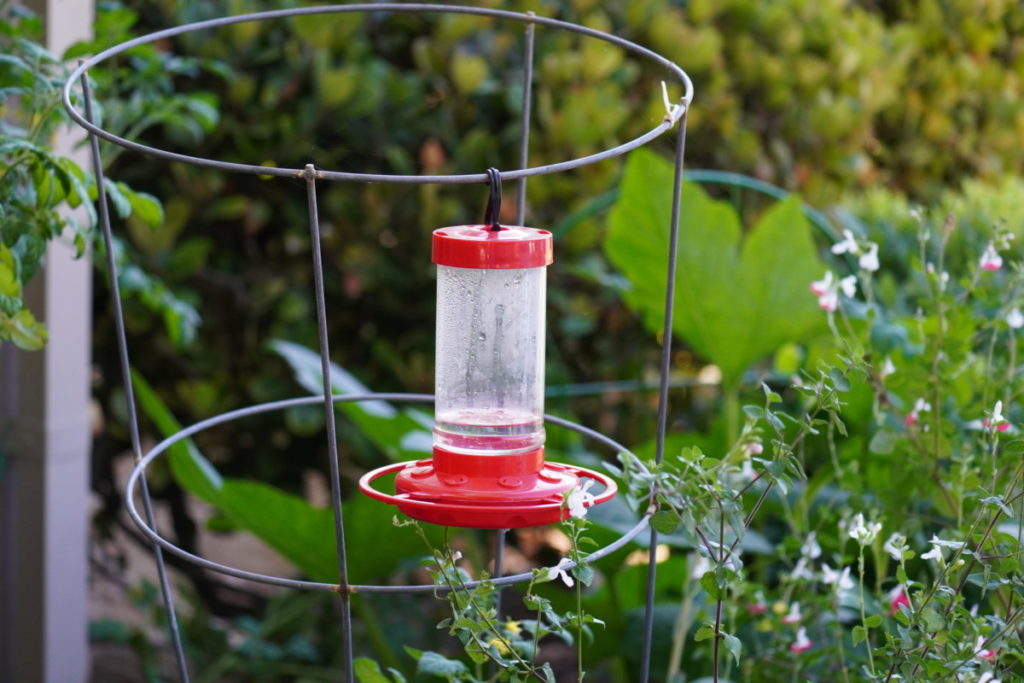
Hot Lips – Salvia microophylla
Position and hang a hummingbird feeder at least 5 feet off the ground and 10-15 feet from trees and bushes, preferably in the shade. This allows hummingbirds to rest and conserve energy while staying out of the sun and able to keep a close eye on their protected food source.
Multiple feeders should be placed 10-12 feet apart making aggressive bullying hummingbirds work harder defending their territory and allowing the docile hummingbirds time to feed comfortably.
When deciding on where to place a feeder, keep in mind that shade is a high priority. Heat tends to spoil the homemade nectar, therefore consider finding the most shaded part of your yard which would be facing the east.
The sun rises in the east and sets in the west, therefore morning sunlight coming from the east is milder in contrast with the harsh afternoon sunlight coming from the west.
If sun exposure is inevitable, place your feeder on the east with trees behind it on the west side so that when the sun sets in the west, your feeder is protected from the hot afternoon sun by the trees.
Hummingbirds will feed next to a regular bird feeder. They are comfortable co-mingling safely with other birds where both feeders are utilized in the same outdoor space. The different species of birds will not attack each other but feed pleasantly at their respective feeders. If you live in a multi-residential community, hanging both regular bird feeders and hummingbird feeders may bring more activity for your entertainment.
Fermented Hummingbird Nectar
The negative experience we feel when cutting into an overripe tomato or grabbing a carton of milk from the fridge that is past its expiration date and the disgusted face we make afterward is the same experience fermented or spoiled nectar is to a hummingbird.
Our natural instincts for survival guide and directs us away from these dangers in order to prevent sickness.
A common breeding ground for fermentation and bacterial growth is an unclean or unkept hummingbird feeder filled with over-sweetened homemade nectar placed in direct sunlight for hours at a time. The combination of heat, thickened homemade nectar and bacteria from dirty feeders creates a perfect petri dish for disease transmission.
Four common diseases spread by hummingbirds include:
- Candidiasis (fungal tongue infection)
- Avian poxvirus (tumor growths on beaks)
- Aspergillosis (type of mold/fungus)
- Salmonellosis (bacterial)
Transmission of deadly diseases is linked to improper, infrequently cleaned, or overcrowded hummingbird feeders.
To learn more, see my article: Hummingbird Diseases: From Pathogens to Prevention
In order to save the lives of our hummingbird friends, constantly and continually clean your feeders. Frequent cleanings eliminate mold and mildew from building in your feeder. It is important to increase the regular cleaning of feeders during warm weather when conditions intensify and enhance bacterial growth.
Plastic feeders can cause homemade nectar to ferment more quickly than glass feeders during the warm weather season. If you use a plastic feeder make it a habit to frequently change the nectar sooner than you would with a glass feeder.
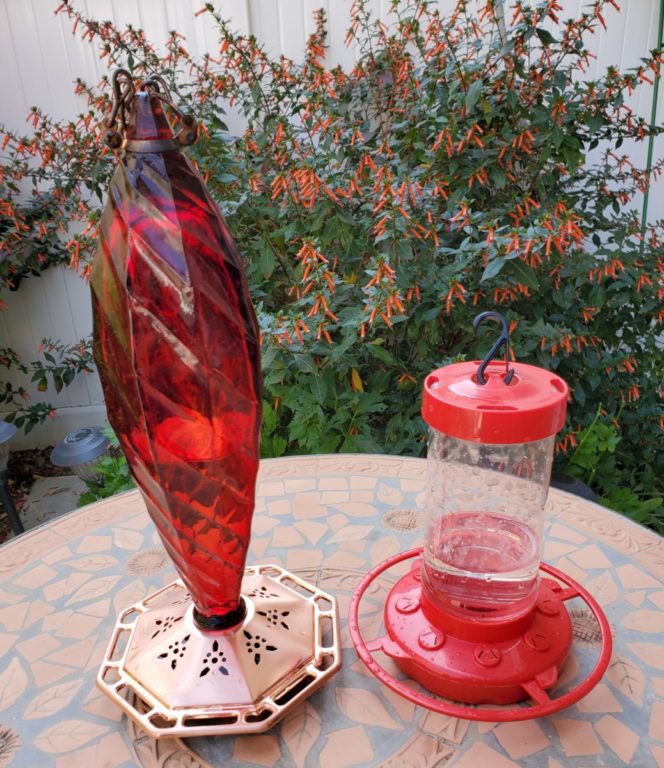
Right: Plastic feeder (wide base)
Note: Your goal is to purchase a red or clear glass feeder with a wide base and use clear homemade nectar.
The red glass feeder above has a very narrow opening making it difficult to clean.
See my article: Forget Commercial Hummingbird Food Try Making Homemade Nectar
Bees on Feeder
Bees are looking for sugar and water and these two ingredients are especially important on a hot summer day. A large population of bees swarming around a hummingbird feeder is a depressing state of affairs. It is painful to watch a group of bullying bees bogarts a feeder while they prevent a patiently waiting hungry-mouthed hummingbird from feeding.
These pesky insects are looking for food and water through no fault of their own, however, there are a few tips on discouraging bees from visiting hummingbird feeders.
Bees are attracted to the color yellow and see the color red as black.
Therefore, choosing hummingbird feeders with an all-red base and red flowers will discourage the bees and entice the hummingbirds.
If the homemade nectar is too sweet, such as 1 part sugar to 2 parts water instead of the recommended 1 part sugar dissolved in 4 parts water, this can attract bees and other uninvited guests. Reducing the sugar-to-water ratio to 1 part sugar to 5 parts water when making your homemade hummingbird nectar is a way to reduce bees around your feeder.
However, it will also make it less attractive for the hummingbirds you are trying to attract. It will take some experimentation to control bees and still attract hummingbirds with this technique of discouraging bees.
Wasps are just after the water, they are carnivorous, so they will not be discouraged by a lower concentration of sugar.
Check to see if your feeder is leaking. These sweet droplets will attract unwanted insects. The cause of a leaky feeder can be due to the plastic being in constant direct sunlight or not having a solid tight seal on your glass feeder.
Plastic feeders in direct sunlight will over time become brittle and cause the plastic to crack and leak. Replace your feeder if you believe your feeders are leaking. And most importantly, clean your feeders regularly.
See my article: Bees On My Hummingbird Feeder: (9 Tips To Get Rid of Them)
Seasonal Migration
Migrating hummingbirds rely on the sun to determine when to begin their migration. The amount of daylight in a day indicates the seasonal changes.
Their internal biological clock decides the appropriate time to increase their fat supply and eat more enriched food in preparation for a long migration journey.
Hummingbirds begin traveling north to their breeding and nesting grounds during the spring then travel south on their return to the tropics for the winter. During the first wave of migrants, males migrate a week or two before the females and juveniles who bring up the second wave of migrants.
During peak migration, hummingbirds travel between April to September. There is less migration activity during the month of June because the hummingbirds are actively nesting.
Lay-over resting habitats along the way are crucial for successful migration and the reason why you will see seasonal fluctuations of activity. It is always important to keep fresh feeders full especially for those traveling migrants just passing through the area. They will be extremely grateful with your small acts of kindness which help them succeed with their migration.
If you are a person that takes your hummingbird feeders down for the winter, be sure to redeploy them very early in the spring before the migration north starts to happen.
Hummingbirds have great memories and can remember EVERY flower or feeder they visited on their migration north and will return to those same flowers and feeders on their return south for the winter. This will ensure an increase in traffic during fall migration.
Potential Predators
Home pets such as your cat or dog are predators to your friendly flying outdoor companions. Pets have a natural instinct to hunt and protect their territory. Just their presence around the hummingbird feeders will discourage many from visiting and they will find a safer alternative location.
Some other common hummingbird predators are hawks, roadrunners, orioles, crows, blue jays, frogs, fish, spiders, and praying mantis.
Hummingbirds are brave when defending their territory or their nesting grounds and will attack bluejays, hawks, and other large birds. However, in a worst-case scenario, these same birds will sometimes swoop down and devour the hummingbird.
Spiders and their webs are difficult to detect unless the sunlight hits them at a certain angle or dewdrops glisten on the web.
Just as you may have experienced inadvertently walking into a spider’s web, hummingbirds have been known to get stuck and entrapped themselves becoming exhausted while struggling for freedom. The tensile strength of spider silk is so strong that most of the time the birds need assistance from a human to break free.
Like all killers, a praying mantis has patience on their side and is known to wait for hours before attacking and capturing the right victim. They rest on plants near hummingbird feeders and are known to actually wait patiently on a feeder.
Due to the praying mantis’ killing technique when attacking, their movement is lightning-fast resembling an assassin.
Once the hummingbird is captured, the praying mantis holds the hummingbird in a death grip and slowly takes all day to eat the brains.
For more things that kill hummingbirds, check out my article: 10 Common Things That Kill Hummingbirds
Conclusion
Experiencing an abundance of hummingbirds one year and a scarcity the next, is disheartening.
Nature has its own timetable making it challenging to know exactly how long it takes a hummingbird to find a feeder. However, keeping in mind when the hummingbirds migrate and providing them with an attractive oasis will increase your odds exponentially.
Hanging feeders in a desired area away from predators surrounded by attractive nectar-producing plants and providing a high vantage point for your hummingbird to administer cross-traffic viewing will gain the attention of attracting hummingbird populations.
When you see an abundance of hummingbirds, take the time to enjoy and cherish their presence, entertainment, and companionship.
Check out my other posts on Hummingbird Questions
Happy Hummingbird Watching!
Backyard Visitors participates in affiliate programs which compensate us for referring traffic.

